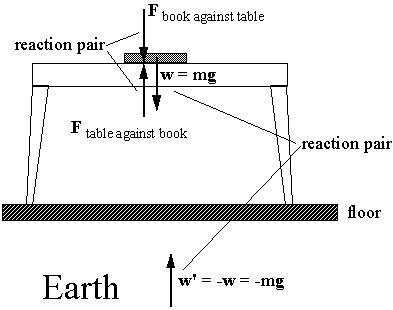Balance of Forces: Part 1
Now that we have discussed lift, we think we should discuss the nature of quadcopter motion and its foundation in Newton's laws. Newton's third law states that for every action (or force) there is an equal and opposite reaction (or force). This is actually not a very intuitive concept when you think about it. Just imagine taking a walk and every time you push off the ground it pushes back up on you. You don't feel pushed do you? Imagine leaning against a wall. For all the force on the wall, you don't feel like you're being pushed do you? You don't feel the way you did when your sibling shoved into the pool in the summer right?
Let's consider some more examples.
- A gun pushes a bullet. And the bullet pushes back on the gun. This is a contact force example.
- A ball in the air is pulled by the earth. And the earth (yes) is pulled by the ball. This is gravitational force example (with a surprise).
- A book lays on a table (which sits on the earth). Book pushes table. Table pushes back. And likewwise for table and Earth. This is a slightly more complex contact example.
To help explain some of these cases, let's consider Newton's first and second laws as well now. His first law says that an object will maintain its intertia (which is the product of mass and velocity) unless acted on by a force. This boils down to an object of a set mass will not change its speed (or stillness) or direction unless acted on by a nonzero net force. Newton's second defines what a force is. A force accelerates a mass directly proportional to the inverse of the mass. Therefore a force is defined as the product of mass and accerlation. (The same force will accelerate a large mass less and a small mass more).
Now let's go back to the examples. When a bullet is fired out of a gun it experiences a force that provides an initial acceleration out of the gun as defined by Newton's second law. That same force pushes back on the gun. However the gun is of such greater mass that the accerlation is smaller. This is commonly called recoil. (This example doesn't dive into the physics behind a recoil pad or muzzle break. We will leave it simply here.) Finally, once the initial force is gone the bullet will no longer be accerlated forward and would in fact continue forever if not for drag forces that act on it from the air and gravitational force from the earth. Eventually the bullet slows down and falls to earth.
Source: Wired
(For those of you with a background in physics or calculus you might heard this as an example for conservation of momentum. The product of mass and velocity is conserved in a system. Therefore the mometum in the bullet and the gun must be the same. This easily proved by integrating the force over a time interval because a force is equivalent to the time rate of change of momentum. The same holds if you come at this from Einstein's conservation of energy principle given that momentum and kinetic energy us the same variables. But let's continue.)
The second example is trickier only because the earth infinitely times more massive. Thus, the accerlation of the earth is infinitely smaller, essentially zero. So the ball really is falling to Earth. Earth isn't so interested in coming up to meet the ball. There is also a force pair between the ball and the air necessary to mention for completeness of explanation but not necessary for illustration in this case (surprise!). And technically we could mix the sun into this but that's beating a dead horse.
The final example is a static (non-moving) example that may prove helpful as well. In this case the book remains at rest (Newton's first law) because it not acted on by a non-zero net force. What are the forces? Gravity pulling down and the earth pushing up with the table caught in between (you may have heard this example before where the forces on the book were covered but the forces on the table were omitted). The book is static because the table pushes up just as much as gravity pulls down. And the table is static because the earth pushes back up too with a force equal to the weight of the book and the table combined.
 Source: WSU
Source: WSU
It can be hard to wrap your head around all of the forces acting in a situation - especially when you consider kinetic and static friction. But this lays the foundation. For a more formal treatment, you might benefit from visiting a site like Khan Academy.